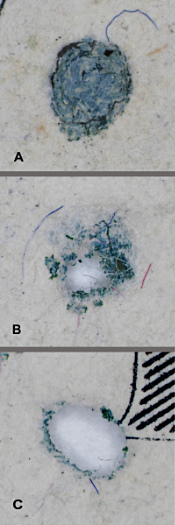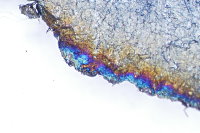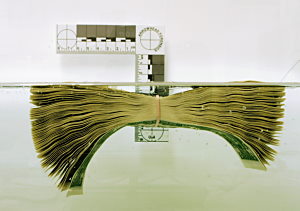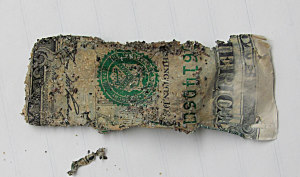|
Fact: Bundles of twenty dollar bills found on Tena Bar were partially decomposed around the edges. Fact: Some of the Cooper bills were black from unknown causes. |
|
In February 1980 the Ingram family was preparing to build a campfire along the Columbia River at a site called Tena Bar. While digging a fire pit, nine year old son Brian Ingram, uncovered three bundles of twenty dollar bills from the Cooper hijacking. This was the only evidence to turn up in the nine years since the skyjacking so the FBI combed the beach for evidence and experts were called in for further analysis. The conclusions at that time formed the Washougal Washdown Theory that required the money to reach Tena Bar by natural causes. In the fall of 2008 when the Cooper Research Team was invited to examine the bills first hand, the general consensus was that since its discovery, there was no formal examination of the Methods Microscopic examination: Three Cooper bills were hand delivered by the FBI to the author's lab in Arizona for microscopic, elemental and molecular analysis. The bills were imaged front and back starting with a stereo microscope and ending with high-magnification electron microscopes. For comparison, several new one dollar bills that had been submerged in the Columbia River, were returned wet to the lab for examination. Flotation analysis: A bundle of 100, new one dollar bills, was wrapped with a rubber band and set afloat in a tank with distilled water. Images were taken every minute to record the flotation progress. One bundle was placed gently on the surface of the water to float, the second was fully submerged instantaneously and then allowed to float freely. Silver nitrate test: Nitrate test strips were purchased commercially. They were dipped in distilled water and placed on both the blackened and normal Cooper bills. The color change indicated the strong presence of nitrates on the blackened bills. Elemental analysis: Both electron microscopes used in this study utilized energy dispersive spectrometers (EDS) to determine the elemental compositions of the black coatings, the ink and other particles found on the bills. IXRF and Genesis software were used to post-process and analyze the spectra. The majority of EDS spectra were recorded at 15 kVa, < 40% dead time. Samples from Columbia River: Samples of sand were collected from Frenchman's Bar on the Columbia river a few miles upstream from Tena Bar. The sand was collected wet into sterilized jars for analysis back at the lab. Several one dollar bills were sealed in a sterile jar with one inch of river water to test for degradation. Money burial test: A stack of nine new one dollar bills was cut into strips and partially buried vertically in the sand samples from Frenchman's Bar on 1-7-09. The jar was left sealed for 13 months after which the bills were removed and examined. The bill stack was replaced in the jar and a vent hole was added to the cap. The jar remained sealed for an additional 11 months at which time distilled water was added. Additional water was added again on 6-2-11 and 9-3-11. The bills were removed and examined for the amount of degradation over the 33 months they were buried. Discussion Microscopic examination showed that the Cooper bills were severely degraded at the edges and had holes in many places. The holes were examined closely to determine if they were insect boring's, root holes or bacterial colonies. Enough holes were present in various stages of decomposition that it could be determined that the holes were not clean cuts from insects, but appeared to start as a color change (Fig. 1A) progressing to shredding of the fibers (Fig. 1B), and finally to all the fibers in the hole disappearing (Fig. 1C). This is most consistent with a bacterial colony that is consuming the paper. Immediately apparent on the blackened bills was a rainbow iridescence as shown in Figure 3. This signaled that there was likely a molecular layer on the surface causing light refraction. Subsequent examination under EDS showed that the black The modern bills soaked in the Columbia River were examined using a scanning electron microscope (SEM.) At least three different species of fresh water diatoms were found immediately. Subsequent examination of the Cooper bills found no diatoms. Not seeing any diatoms on the Cooper bills does not guarantee that they are not there, so any final conclusions on this would be speculative. The float test demonstrated that a bundle of bills will only float for a matter of minutes before submerging if there is any agitation in the water. Before sinking, the bills fan out as in Figure 4. Placing this in context with various theories, a rocky bottom stream like the Washougal River would provide continuous obstacles to bundles moving down As demonstrated in testing, the bundles of money fan out individually when under water, while a wet bundle out of the water tends to stick together like a brick. It is theorized that fanned out bundles should become mis-aligned while tumbling along the river bottom over time. While it is impossible to know at this time exactly how the bills were oriented, a clue comes from close examination of one particular Cooper bill. This bill had multiple layers of fragments still adhered to each other at the edge. A closeup of this stacking is shown in Figure 5, and Figure 7 shows the reconstruction. At least three of the bills on top were displaced as shown, but the underlying stack was in relatively close alignment. While it could be argued that the top bills are displaced, the neat alignment of the lower stack would not be a likely result after 20 plus miles of river tumbling. The remaining individual bills can also provide some idea of the stacks alignment during burial. Reviewing the available pictures, it is noted that the bills all degraded from the edges in and all in similar proportions around the entire bill. Had some bills been rotated out of alignment, they would have presented more surface area to the degradation processes in the sand and some corners would have been proportionally more deteriorated. This is not apparent in the majority of the Cooper bills. The money removed from the burial test after 33 months showed almost no degradation (Fig. 6). Conclusions The three bundles of 20 dollar bills found on Tena Bar in 1980 was the only evidence ever found after the hijacking. The simplest explanation that Cooper landed on or near Tena Bar would require that the published flight path was off by many miles, the jump timing would have to be off, and the pilots were not navigating in their normal manner via Victor Airway 23. There is currently no good data indicating that the flight path and timing of Cooper's jump were off enough to have him landing on or near Tena Bar. The lines of investigation during this research could not pinpoint a natural means for moving the money from the woods near Arial Washington to the Columbia River. The rubber band testing outlined in other parts of this research place a constraint of about one year for the bills to become buried on Tena Bar. This places further restrictions on the speed that the bills would have to move by natural processes, further complicating any possible natural method of moving the bundles. If natural means provides no plausible answer, then the other two possibilities are mechanical or
|






